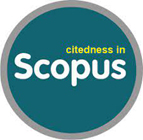The Relationship between Self-Concept and Communication Anxiety in Students: A Quantitative Approach
Abstract
This study measures the relationship between self-concept and communication anxiety in students by collecting research to find the results of problems that exist on campus and the current campus environment. The primary approach in this research is quantitative. The data to be processed quantitatively in this study comes from a questionnaire. The questionnaire method is divided into a subject identity checklist, the Tennessee Self-Concept Scale, and a communication anxiety scale. A sample of 100 students was drawn based on non-randomly selected majors at Pancasila University: Economics, Law, Psychology, Communication, and Pharmacy. Twenty students were selected from each major. The sampling technique used non-probability sampling, namely the side quota technique. There was no significant relationship between self-concept and communication anxiety in students. The results showed an r value of 0.094, which is not significant at α = 0.05. This means there is no correlation between self-concept and communication anxiety. Thus, the null hypothesis (H0) is accepted.
Keywords
Full Text:
PDFReferences
Juliana, & Erdiansyah, E. (2020). Pengaruh konsep diri terhadap kemampuan komunikasi interpersonal pada mahasiswa. Jurnal Koneksi, 4(1), 45–55. https://journal.untar.ac.id/index.php/koneksi/article/view/6500
Kartikasari, A., Roesminingsih, M. V., & Nurlaily, F. (2021). Hubungan antara kepercayaan diri dengan kecemasan presentasi pada mahasiswa. Indonesian Journal of Behavioral Studies, 2(1), 1–10. https://jurnal.radenfatah.ac.id/index.php/ijobs/article/view/9255
Kholisin, M. (2011). Konsep diri dan kecemasan berbicara di depan umum. Jurnal Ilmu Dakwah, 5(2), 95–110. https://journal.walisongo.ac.id/index.php/dakwah/article/view/65
Kusumawati, Y., Lestari, A., & Nirmala, N. (2020). Pengaruh konsep diri dan asertivitas terhadap kecemasan komunikasi interpersonal. Wacana: Jurnal Psikologi, 19(2), 102–110. https://jurnalwacana.psikologi.fk.uns.ac.id/index.php/wacana/article/view/24
Morales-Navarro, L., Méndez, I., & Martínez, R. (2023). The role of self-beliefs in anxiety and communication performance in students. arXiv preprint. https://arxiv.org/abs/2307.10010
Mammarella, I. C., Caviola, S., & Giofrè, D. (2021). Profiles of self-concept and anxiety in adolescents. arXiv preprint. https://arxiv.org/abs/2112.09778
Prastiwi, Y. (2020). Hubungan antara kepercayaan diri dan kecemasan komunikasi pada siswi asrama. Jurnal Studi Psikologi, 3(2), 110–117. https://ejournal.appisi.or.id/index.php/Studi/article/view/20
Retna, P. D., & Junita, A. (2019). Validasi skala kecemasan komunikasi mahasiswa. Jurnal Psikologi Terapan, 7(1), 22–29. https://ojs.unimal.ac.id/index.php/jpt/article/view/2871
Sayis, M., Bakir, M., & Camkerten, E. (2024). The effect of best possible self activity on students’ self-regulation and positive affect. arXiv preprint. https://arxiv.org/abs/2401.08424
Siska, Y., Mahmudah, S., & Arifin, S. (2024). Hubungan kepercayaan diri dengan kecemasan komunikasi interpersonal pada mahasiswa. Jurnal Psikologi Indonesia, 21(1), 35–42. https://jurnal.ugm.ac.id/jpsi/article/view/7025
Sunardi. (2018). Hubungan konsep diri dengan kecemasan komunikasi berbicara di depan umum pada mahasiswa. Psympathic: Jurnal Ilmiah Psikologi, 5(1), 55–65. https://journal.uinsgd.ac.id/index.php/psy/article/view/2186
Winarni, N. (2017). Kepercayaan diri dan kecemasan komunikasi publik pada mahasiswa. Cognicia: Jurnal Ilmiah Psikologi, 5(2), 73–80. https://ejournal.umm.ac.id/index.php/cognicia/article/view/1647
Higgins, E. T. (1987). Self-discrepancy: A theory relating self and affect. Psychological Review, 94(3), 319–340. https://doi.org/10.1037/0033-295X.94.3.319
McCroskey, J. C. (1977). Oral communication apprehension: A summary of recent theory and research. Human Communication Research, 4(1), 78–96. https://doi.org/10.1111/j.1468-2958.1977.tb00599.x
Ibrahim, M. (2019). Pengelolaan kecemasan dalam komunikasi antarbudaya. Jurnal Kajian Komunikasi, 7(2), 145–153. https://jurnal.unpad.ac.id/jkk/article/view/19620
Fitts H.W. (1971). The self-concept & behavior: overview & sulement. Monograph VII. USA: Dede Wallance
Gravetter F.J. & Wallance L. B. (2007). Statistics for the behavior science 7th ed. California: Thomson Wadsworth
Hurlock E.D. (1980). Psikologi perkembangan, suatu pendekatan sepanjang rentang kehidupan (edisi 5). Alih bahasa: Istiwidayanti, Soedjarwo, & Ridwan Max Sijabat. Jakarta: Erlangga
Kumar R. (2005). Research methodology: a step-by-step guide for beginners 2nd edition. London: Sage Publication
Mayer D.G. (1992). Social psychology 2th ed. Singapore: Mc Graw-Hill, inc
Roekminiwati. (2002). Hubungan antara konsep diri dengan kecemasan komunikasi pada mahasiswa sekolah tinggi ilmu statistik. Skripsi. Depok: Fak. Psikologi UI
Russel F.A. (1988). Selling principles and practices. New York: Mc.Graww-Hill, inc
Sarwono S. W. (1997). Psikologi sosial individu dan teori-teori psiokologi sosial. Jakarta: Balai Pustaka
Efianingrum, Ariefa, Mengurai Akar Kekerasan (Bullying) di Sekolah, Jakarta: Jurnal Dinamika, 2015.
Enny Widiastuti, S.Pd. Wawancara, Kepala sekolah SD Negeri 106796.
Gunawan, Heri, Pendidikan Islam: Kajian Teoritis dan Pemikiran Tokoh, Bandung: Remaja Rosdakarya, 2014.
Irnie Victorynie, Mengatasi Bullying Siswa Sekolah Dasar Dengan Menerapkan Manajemen Kelas Yang Efektif, (Jakarta: Jurnal Pedagogik Vol. V, No.1, Februari 2017.
Michael Hangga Wishbharata, Kompas.com dengan judul “Marak Kasus Bullying” di Indonesia, Kompas.com, 2022.
Retno., P.Astuti, Meredam Bullying: 3 Cara Efektif Mengatasi Kekerasan Pada Anak, Jakarta: PT Grasindo, 2021.
Rina Kritina Sitepu, S.Pd. Wawancara, Guru Wali kelas SD Negeri 106796.
Salim dan Syahrum, Metodologi Penelitian Kualtatif dan Kuantitatif, (Medan: UINSU, 2014), hlm. 164.
Salsa Yunanda, Rr. Nanik Setyowati, Peran Guru dalam Mengatasi Tindakan School Bullying Sebagai Upaya Mewujudkan Sekolah Ramah Anak di SMP Negeri 2 Wates Kab. Kediri, (Kediri: JCMS Vol. 7, No. 1, 2022, Hal 30-43.
Sri Rejeki, Pendidikan Psikologi Anak dan Anti Bullying pada guru-Guru PAUD dalam Jurnal Dimas Volume-16, No.2, Yogyakarta: DIMAS, 2016
Soedjatmiko, Nurhamzah, W., Maureen, A., & Wiguna, T. Gambaran Bullying dan Hubungannya dengan Masalah Emosi dan Perilaku pada Anak Sekolah Dasar. Jurnal Sari Pediatri. Vol. 15. No. 3. Oktober 2013.
Sugiyono, Metode Penelitian Kualitatif, Cet.3. (Bandung: Alfabeta, 2021). hlm. 106-108.
Triska Fadilah, S.E. Wawancara, Staff TU SD Negeri 106796.
Wawancara peserta didik kelas IV SD Negeri 106796.
Zahrani, Dian Ayu, Model Program Intervensi Anti Bullying Berbasis Sekolah, Jurnal LITE, Volume 15 Nomor 2 Tahun 2019.
DOI: http://dx.doi.org/10.58836/jpma.v16i1.25641
Refbacks
- There are currently no refbacks.

This work is licensed under a Creative Commons Attribution-NonCommercial 4.0 International License.
 |  |  |  |  |  |  |
Jurnal Penelitian Medan Agama
This work is licensed under a Creative Commons Attribution-NonCommercial 4.0 International License.











